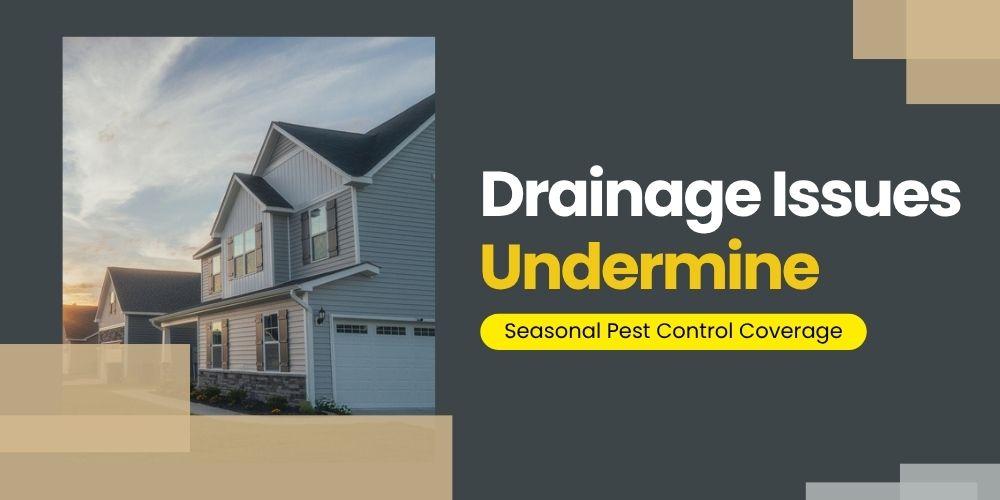Drainage Issues Undermine Seasonal Pest Control Coverage

Are you wondering why pests keep coming back? The culprit may be water pooling near your foundation. While seasonal pest control provides strong coverage, poor drainage can reduce its effectiveness by attracting pests and giving them a place to thrive. Moisture creates ideal conditions for infestations, so fixing these issues early gives treatments a better shot at success. Keep reading to see where to start.
How Standing Water Attracts Pests
Standing water creates favorable conditions for many pests. Whether caused by poor drainage, clogged gutters, or leaky outdoor fixtures, stagnant water increases the risk of infestations. The following outlines how stagnant water draws different pests and interferes with prevention efforts:
-
Breeding ground for mosquitoes: They need stagnant water to lay eggs. Birdbaths, clogged gutters, and puddles can produce hundreds of larvae in days.
-
Attracts rodents and insects: Rodents, ants, and cockroaches seek water when other sources run dry. Water collecting near basements, decks, or foundations often brings these pests indoors.
-
Encourages organis growth: Stagnant water promotes mold, algae, and other buildup. This environment attracts gnats and insects that feed on decaying matter.
Regularly removing water and improving drainage support the overall success of your seasonal pest prevention plan.
Why Drainage Problems Disrupt Seasonal Pest Control Plan
Even the most strategic pest management efforts can fail when drainage problems go unchecked. The following explains how excess moisture interferes with seasonal pest control:
-
Attracts moisture-loving pests: Standing water near the home draws mosquitoes, ants, and cockroaches, making pest prevention more difficult during wet seasons.
-
Forces pests indoors: Saturated soil or pooled water around the foundation often pushes pests into basements, crawl spaces, and walls for drier shelter.
-
Reduces treatment effectiveness: Drainage issues can wash away or dilute outdoor pest control products, limiting coverage and reducing long-term protection.
-
Encourages decay and pest habitat: Water buildup promotes mold and wood rot, which attracts insects like termites and carpenter ants that thrive in damp, deteriorating material.
Address any drainage concerns early to support a successful seasonal pest control strategy. Proper water management also strengthens your defense against recurring pest activity.
Common Signs of Drainage Issues That Affect Pest Coverage
Drainage problems can silently disrupt your home’s pest protection. Over time, poor water flow may weaken the effectiveness of the seasonal pest prevention plan by creating moisture-rich environments where pests thrive. Watch for the following common signs:
-
Standing water near the foundation: Water pooling near your home attracts mosquitoes and provides entry points for ants and rodents.
-
Mildew or mold growth on exterior walls: Excess moisture supports fungal growth, often drawing in insects like springtails and fungus gnats.
-
Soggy or uneven soil: Saturated soil may signal poor drainage and allow pests to access the foundation easily.
-
Overflowing gutters: When gutters fail to divert water, they pool near the home and compromise exterior pest barriers.
By recognizing these drainage-related issues early, you can address the source and maintain the effectiveness of your seasonal pest control plan.
Fix These Drainage Problems to Protect Seasonal Coverage
Unresolved drainage issues can undermine your seasonal pest control efforts by creating environments where pests flourish. It’s essential to take proactive steps to correct them. Take the following steps to protect your seasonal pest prevention efforts:
-
Clear gutters and downspouts: Remove leaves and debris regularly to ensure water flows away from the foundation, limiting pest access points.
-
Improve yard grading: Adjust the soil slope so water drains away from your home rather than pooling near the base.
-
Fix broken drain pipes: Replace damaged pipes to prevent hidden leaks that create moist areas attractive to insects and rodents.
-
Fill low spots: Fill in depressions where water collects to avoid standing pools that support mosquito breeding and other pest activity.
Managing these problems safeguards your property from moisture damage and supports the effectiveness of your seasonal pest control plan.
Drainage and Seasonal Pest Control Work Best Together
Even the best seasonal pest prevention plan won’t deliver full results if water collects around your property. Standing water and soggy soil attract pests faster than treatments can keep up. However, you set your home up for absolute protection by managing drainage alongside your pest plan. If you want longer-lasting results, check out the seasonal pest control you should know in Bixby, OK, and take the next step to keep bugs out for good.
- Pest_extermination
- Bed_bug_heat_treatment
- Heat_treatment_for_pests
- Thermal_pest_control
- Pest_removal
- Residential_pest_control
- Commercial_pest_control
- Integrated_pest_management
- Pest_inspection
- Pest_prevention
- Insect_control
- Rodent_control
- Termite_treatment
- Wildlife_control
- Pest_control_services
- Pest_control_company
- Heat_treatment_solutions
- Eco-friendly_pest_control
- Professional_exterminators
- Pest_infestation
- Heat_treatment_process
- Safe_pest_control_methods
- Pest_control_consultation
- Pest_control_maintenance
- Heat_treatment_technology
- Pest_control_experts
- Pest_control_assessment
- Effective_pest_control
- Residential_heat_treatment
- Art
- Causes
- Crafts
- Dance
- Drinks
- Film
- Fitness
- Food
- الألعاب
- Gardening
- Health
- الرئيسية
- Literature
- Music
- Networking
- أخرى
- Party
- Religion
- Shopping
- Sports
- Theater
- Wellness
